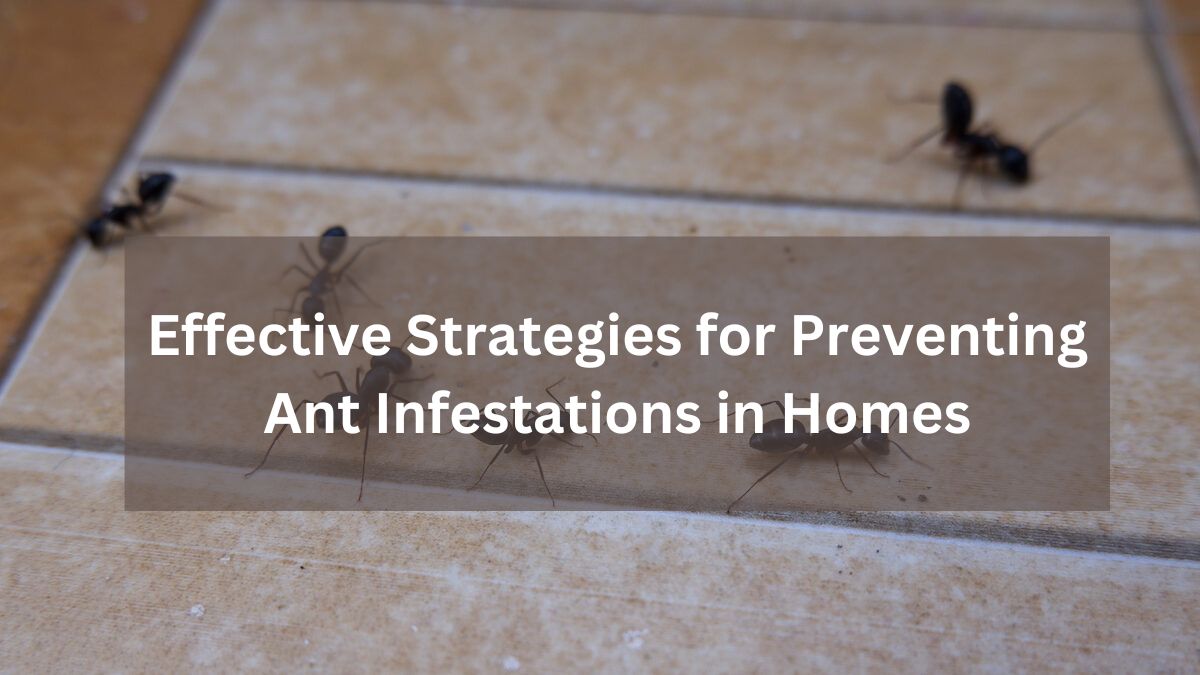
Ant infestations can be a common nuisance in both homes and gardens, disrupting our daily lives and causing damage to property. These tiny insects are highly adaptable and can quickly establish colonies, making them challenging to control once an infestation takes hold. However, by implementing effective preventive strategies, it is possible to minimize the risk of ant infestations and keep these unwanted guests at bay.
Understanding the behavior and habits of ants is crucial for developing a comprehensive prevention plan. Different ant species exhibit unique nesting habits and foraging patterns, which can influence the strategies employed to deter them. Additionally, maintaining cleanliness and hygiene, blocking entry points, removing attractants, and creating barriers are essential steps in preventing ant infestations in homes and gardens.
Proactive measures, such as removing outdoor nests and colonies, proper waste management, and seeking professional pest control assistance when needed, further contribute to a comprehensive ant prevention strategy. Monitoring and early detection play a vital role as well, allowing homeowners to identify ant activity before it escalates into a full-blown infestation.
Understanding Ant Behavior and Habits:
To effectively prevent ant infestations in homes and gardens, it is important to have a basic understanding of ant behavior and habits. Different ant species may exhibit varying preferences and tendencies, so being aware of these factors can inform your preventive strategies. Here are key points to consider:
Identifying common ant species: There are numerous ant species, but some common ones include pavement ants, carpenter ants, and pharaoh ants. Research and identify the species prevalent in your region, as their behavior and nesting habits can differ.
Learning about ant nesting habits: Ants can establish nests both indoors and outdoors. Indoor nests are commonly found in wall voids, behind baseboards, or in areas with moisture and food sources. Outdoor nests can be located in soil, under rocks, or within decaying wood. Understanding where ants prefer to nest will help you target preventive measures.
Recognizing ant foraging patterns: Ants have a well-organized system of foraging, following chemical trails they create with pheromones. They seek out food sources and communicate the location to the colony. Observing their foraging patterns can help you identify entry points and areas where attractants may be present.
By familiarizing yourself with these aspects of ant behavior, you can develop specific strategies to deter them effectively. For example, if you identify carpenter ants as a common species in your area, paying attention to potential wood damage and addressing moisture issues becomes crucial. Similarly, understanding their foraging patterns allows you to disrupt their trails and remove attractants in your home and garden.
Remember that professional pest control experts can provide valuable insights and help identify specific ant species and their behaviors in your region. By combining your knowledge of ant behavior with targeted preventive measures, you can significantly reduce the risk of ant infestations and maintain a pest-free environment.
Maintaining Cleanliness and Hygiene
One of the fundamental strategies for preventing ant infestations in homes and gardens is to maintain cleanliness and hygiene. Ants are attracted to food sources and crumbs, so eliminating these temptations can discourage them from invading your space. Here are some key points to consider:
Keep indoor spaces clean and free of food debris: Regularly sweep and mop floors, especially in the kitchen and dining areas. Vacuum carpets and rugs to remove any crumbs or food particles that may attract ants. Wipe down countertops, tables, and other surfaces to eliminate traces of food.
Properly store food and dispose of waste: Store food in airtight containers to prevent ants from accessing it. This applies to both pantry items and pet food. Make sure garbage cans have tightly sealed lids to prevent ants from scavenging for food scraps. Regularly empty trash cans and dispose of waste in a sanitary manner.
Regularly clean kitchen surfaces and appliances: Clean up spills and crumbs promptly, paying particular attention to kitchen surfaces, stovetops, and inside appliances like toasters and microwaves. Even small food residues can attract ants, so thorough cleaning is essential.
Repair leaky faucets and address moisture issues: Ants are also attracted to sources of moisture. Fix any leaky pipes or faucets to eliminate excess moisture that may attract ants. Wipe down sinks and countertops to prevent water buildup.
By practicing cleanliness and hygiene, you create an environment that is less attractive to ants. Without easily accessible food sources and crumbs, ants are less likely to infest your home or garden. Consistency is key, so make these habits a part of your regular cleaning routine.
Blocking Entry Points and Using Ant Killers:
In addition to maintaining cleanliness, blocking entry points is a crucial strategy for preventing ant infestations in homes and gardens. By sealing off their access routes, you can create barriers that make it difficult for ants to invade your space. Here are some key points to consider:
Sealing cracks and gaps: Inspect your home for any cracks, gaps, or openings that ants can use as entry points. Common areas to check include windows, doors, utility lines, and foundation gaps. Use caulk or sealant to seal these openings and prevent ants from entering.
Installing weatherstripping and door sweeps: Ensure that doors and windows have proper weatherstripping installed to close any gaps. Install door sweeps at the bottom of exterior doors to block potential entry points for ants.
Repairing damaged screens and vents: Inspect window screens and vents for any tears or holes that ants can exploit. Repair or replace damaged screens to keep ants from entering your home. Use fine mesh screens for attic and foundation vents to prevent ant intrusion.
Applying ant killers strategically: As part of your preventive measures, consider using ant killers in areas prone to ant activity or along known entry points. Ant killers, available in various forms such as sprays, granules, or baits, can help eliminate ants and deter them from returning. Follow the product instructions carefully for safe and effective use.
When using ant killers, it is important to choose products that are safe for your home and environment. Look for ant killers labeled for indoor use if applying inside your home. For outdoor use, opt for products designed to be effective against ants while minimizing harm to beneficial insects and plants.
Removing Attractants
Removing attractants is an essential strategy for preventing ant infestations in homes and gardens. Ants are constantly in search of food and water sources, and by eliminating these temptations, you can discourage them from invading your space. Here are some key points to consider:
Clean up spills and crumbs promptly: Ants are attracted to even the smallest food particles. Immediately clean up any spills or crumbs, especially in areas where food is prepared or consumed. Use a damp cloth or paper towel to wipe down surfaces thoroughly.
Store food in airtight containers: Keep all food, including pantry items, fruits, and pet food, in tightly sealed containers. Ants can easily access open packages and containers, so transferring them to airtight options helps prevent infestations.
Empty garbage cans regularly: Dispose of garbage regularly, especially food waste. Make sure garbage cans have tightly sealed lids to prevent ants from accessing them. Consider using sealed compost bins for organic waste in the garden.
Clean pet bowls: After feeding your pets, promptly clean their food and water bowls. Ants are attracted to pet food, so ensure any leftover food or spills are cleaned up to minimize the risk of ant infestation.
Remove standing water and fix leaks: Ants are also attracted to water sources. Eliminate standing water in and around your home and fix any leaky faucets or pipes. Pay attention to areas like sinks, bathrooms, and outdoor faucets.
Trim vegetation near the house: Ants can use branches and vegetation as bridges to access your home. Trim trees, shrubs, and other plants that come in contact with the house to minimize potential entry points for ants.
By removing attractants, you create an environment that is less appealing to ants. Without easy access to food and water sources, ants are less likely to infest your home or garden. Consistently practicing these habits and maintaining a clean environment is key to long-term prevention.
It is important to educate all household members about the significance of removing attractants and their role in preventing ant infestations. Encourage everyone to be mindful of food spills, properly store food, and promptly clean up any messes.
Creating Barriers and Deterrents
Creating barriers and deterrents is an effective strategy for preventing ant infestations in homes and gardens. By implementing measures that discourage ants from entering your space, you can significantly reduce the risk of an invasion. Here are some key points to consider:
Applying non-toxic ant deterrents along entry points: There are various natural ant deterrents that you can use to create barriers along ant entry points. Examples include substances like cinnamon, peppermint oil, vinegar, or citrus peels. Sprinkle these deterrents near windows, doorways, and other potential entry points to discourage ants from crossing these barriers.
Using ant traps and baits strategically: Ant traps and baits can be effective in controlling ant populations and preventing infestations. Place them in areas where ants are frequently seen, such as near ant trails or entry points. The traps attract ants and contain bait that they carry back to their colony, ultimately eliminating the entire nest. Follow the instructions provided with the traps and baits for optimal results.
Planting natural ant repellent herbs and plants: Certain plants and herbs have natural properties that repel ants. Consider planting these in your garden or placing potted versions near entrances and windowsills. Examples of ant-repellent plants include mint, lavender, rosemary, and sage. Not only do they serve as natural deterrents, but they also add beauty to your surroundings.
Maintaining a clean and tidy garden: A well-maintained garden can help discourage ants from establishing colonies nearby. Regularly remove decaying wood, fallen leaves, and other debris where ants may seek shelter or build nests. Trim back vegetation that comes in direct contact with your home, as it can serve as a bridge for ants to access your property.
Eliminating ant trails: When you spot ants trailing inside your home or garden, clean the area with a vinegar-water solution or mild detergent. By disrupting their chemical trails, you can deter ants from returning to the same paths.
Repairing structural issues: Inspect your home for any structural issues that may provide easy access for ants, such as gaps in walls, damaged siding, or loose mortar. Repair these issues promptly to deny ants entry points.
Remember that while these barriers and deterrents can be effective, they may not provide complete eradication of ants. For severe or persistent infestations, it may be necessary to seek professional pest control assistance.
By combining the creation of barriers and deterrents with other preventive strategies, such as maintaining cleanliness and blocking entry points, you create multiple layers of defense against ant infestations in your home and garden.
Educating and Engaging the Community:
Educating and engaging the community is a valuable strategy for preventing ant infestations in homes and gardens. By promoting awareness and responsible pest management practices, you can create a collective effort to reduce ant problems in your neighborhood. Here are some key points to consider:
Share information and tips with neighbors and friends: Start by sharing your knowledge and experiences with neighbors and friends. Discuss the importance of ant prevention and the strategies you have implemented. Encourage open communication and the exchange of ideas to foster a community-wide approach to ant control.
Participate in local community pest control programs: Many communities have pest control programs or initiatives aimed at addressing common pest issues. Get involved in these programs and attend workshops or seminars on pest prevention. By actively participating, you can learn from experts, share insights, and collaborate with others in your community.
Promote awareness through social media and community groups: Utilize social media platforms and community groups to raise awareness about ant prevention. Share informative articles, helpful tips, and success stories related to ant control. Encourage community members to ask questions, share their experiences, and support one another in their efforts to prevent ant infestations.
Organize neighborhood clean-up events: Coordinate neighborhood clean-up events focused on removing potential ant attractants. This can involve activities like clearing debris, cleaning common areas, and addressing specific ant-prone areas in the community. These events not only help prevent ant infestations but also foster a sense of unity and shared responsibility.
Collaborate with local schools and organizations: Engage local schools, gardening clubs, or environmental organizations to educate students and community members about ant prevention. Offer workshops, presentations, or hands-on activities that teach practical strategies for preventing ant infestations. Encourage participation in gardening projects that emphasize ant-repellent plants and responsible pest management practices.
By educating and engaging the community, you can create a broader impact in preventing ant infestations. Through shared knowledge, collaboration, and collective action, you can foster a community that is proactive in pest prevention, leading to healthier homes and gardens for everyone.



